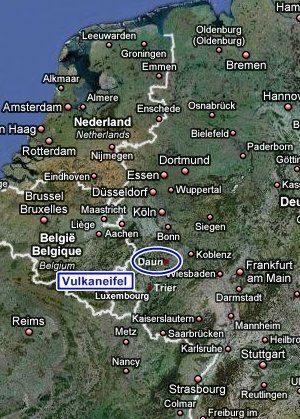 | ||
Similar Laacher See, Eifel, Schalkenmehrener Maar, Maria Laach Abbey, Ahr | ||
The Volcanic Eifel or Vulkan Eifel (German: Vulkaneifel) is a region in the Eifel Mountains in Germany, that is defined to a large extent by its volcanic geological history. Characteristic of this volcanic field are its typical explosion crater lakes or maars, and numerous other signs of volcanic activity such as volcanic tuffs, lava streams and volcanic craters like the Laacher See. The Volcanic Eifel is still volcanically active today. One sign of this activity is the escaping gases, for example, in the Laacher See.
Contents
- Map of Volcanic Eifel 56769 Mannebach Germany
- Geographical locationEdit
- VolcanoesEdit
- Geopark and museumsEdit
- References
Map of Volcanic Eifel, 56769 Mannebach, Germany
Geographical locationEdit
The Volcanic Eifel stretches from the Rhine to the Wittlich Depression. It is bordered in the south and southwest by the South Eifel, in the west by the Luxembourg and Belgian Ardennes and in the north by the North Eifel including the Hohes Venn. To the east the Rhine forms its geographical boundary; with no volcanicity immediately beyond it.
The Volcanic Eifel is divided into three natural regions:
The centre of the Volcanic Eifel is the region around Daun and Manderscheid and the areas within the Mayen-Koblenz district.
The landscape of the Volcanic Eifel is dominated by recent volcanism. Volcanic craters, thick pumice and basalt layers and maars create a diverse landscape, that clearly witnesses to very recent events in geological terms.
The entire Volcanic Eifel covers an area of about 2000 km² and as of 2007 has a population of about 200,000.
VolcanoesEdit
The following volcanoes belong to the Eifel, sorted by height in metres (m) above sea level (Normalhöhennull, NHN):
→ See also: List of mountains and hills of the Eifel
